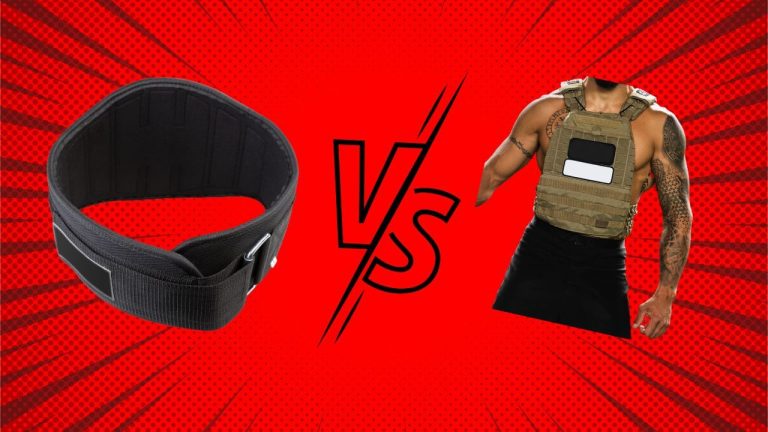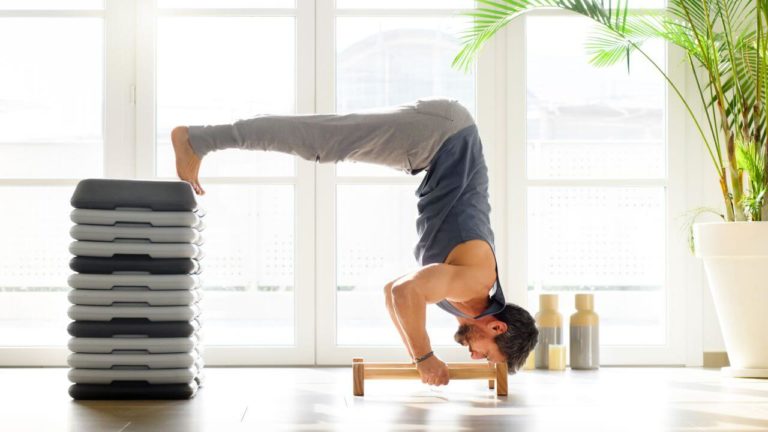Gymnastics Rings – The Only Calisthenics Equipment You Need
Gymnastics rings are the ultimate and most important piece of calisthenics equipment for every athlete interested in bodyweight fitness. If there was only one fitness instrument we could take with us to a deserted island it would be a set of rings – you got to have your priorities straight.
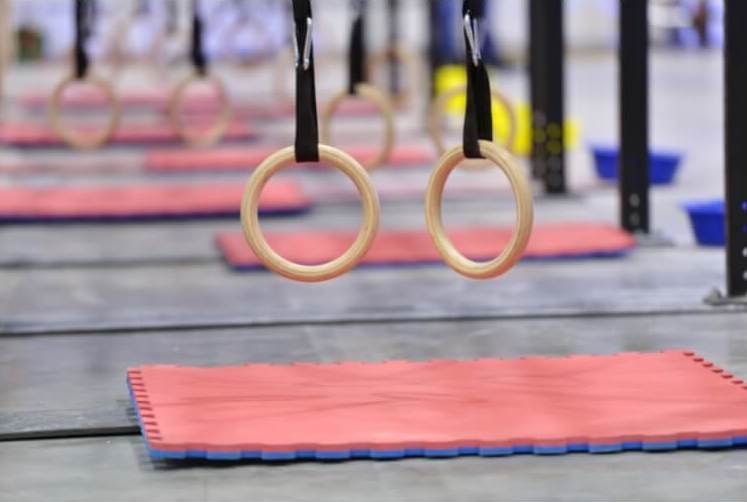
What are the benefits of gymnastics rings?
One of the main benefits of gymnastics rings is their versatility. While the gymnasts in the Olympics perform exercises of mind-bending difficulty on the same equipment, it doesn’t mean that it is not suitable for complete beginners. Gymnastics rings are the perfect piece of calisthenics equipment for a complete beginner as well as an Olympic champion. Not only that but you can also train your whole upper body just with a set of rings. Almost any pulling or pushing movement variation.
Gymnastics rings are light and fit easily in any backpack so they are ideal for a traveling athlete. Finding a place to hang them from can be challenging though but not a big problem. Just find a stable enough horizontal tree branch in a nearby park and you are good to go.
The best part about gymnastics rings is how cheap and simple they are. They cost around $50 and they can serve you a lifetime. There is no technology, no need to update them every year. There are no pivot points, nothing to break on them.
Since the sizing is universal, you can always borrow one from your friends for your next trip.
In summary, the main benefits of gymnastics rings are that they are:
- Light – easy to travel with
- Packable – fits in a backpack
- Easy setup – only needs a stable horizontal surface
- Universal – one size fits all
- Versatile – whole upper body workout
- Cheap – around $50
- Simple – will not break easily
- Any fitness level – great for beginner to advanced
How to hang gymnastics rings?
Gymnastics rings are the perfect equipment for a home gym because they are easy to install and take up very little space. All you need is a place to hang the straps from. For a minimalist solution, we recommend using a ceiling hook set to hang the straps from. The mounting points should be about 19.7 inches (50cm) from each other. Once set, the ring straps can be detached after every use so they won’t be in the way.
The gymnastics rings can also be set up for any pull or push movement. The good thing about them is that they are easily height adjustable. By adjusting the height of the rings and the position of your feet you can modify the difficulty of exercises and the muscle groups engaged. By putting your feet on a box or chair the difficulty can be further modified.
The gymnastics rings at the Olympics are hanging from a height of 18.8 feet (5.75m) and the rings are 8.2 feet (2.5m) above ground. For home use, these dimensions are not too practical as few of us have such high ceilings.
In order to be able to perform the exercises it is important that the gymnastics rings are set up correctly. For example, to perform a front lever, we have to pay attention to the distance between our head and the wall, when in the fully extended horizontal position.
For example: I am 6.2’ or 188cm tall. If I wanted to do a full muscle up, I would need a ceiling height of 11.1 feet (340 cm). The rings would have to be 7.5 feet (230 cm) from the ground for me to be able to fully extend my legs in a dead hang position and after completing the muscle-up I’d need a further 43 inches (110cm) – the top of the dip – to not hit my head into the ceiling. I could of course modify the muscle up and start from an L-hang position, this way a standard ceiling height would also suffice.
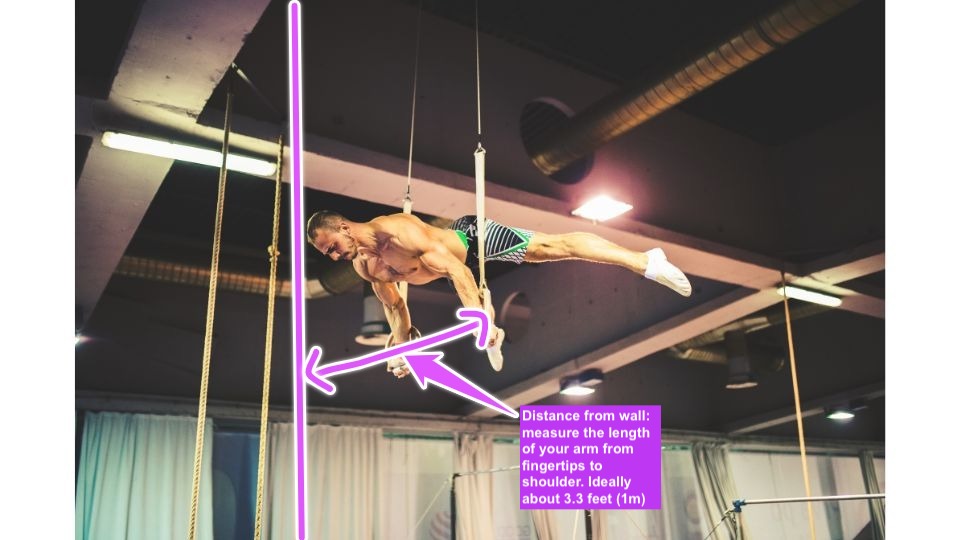
For a planche, front lever, or back lever position we also need to measure the minimum distance from the wall. You can easily determine the ideal position for your gymnastics rings by measuring your body in the following way:
- Distance from the ceiling (measure from knuckles to top of your head). For me it’s about 43” or 110 cm.
- Distance from the wall (measure the length of your arm. From fingertips to shoulder). For me it’s 31.5” or 80 cm. To be safe I’d recommend 3.3 feet or 1m.
- Distance from the floor – for muscle up (Body height + distance between elbow and fingertips). For me it’s 7.55 feet or 230 cm.
- Distance from the floor – for a dip (measure from chest to bottom of your feet). For me it’s 55” or 140 cm.
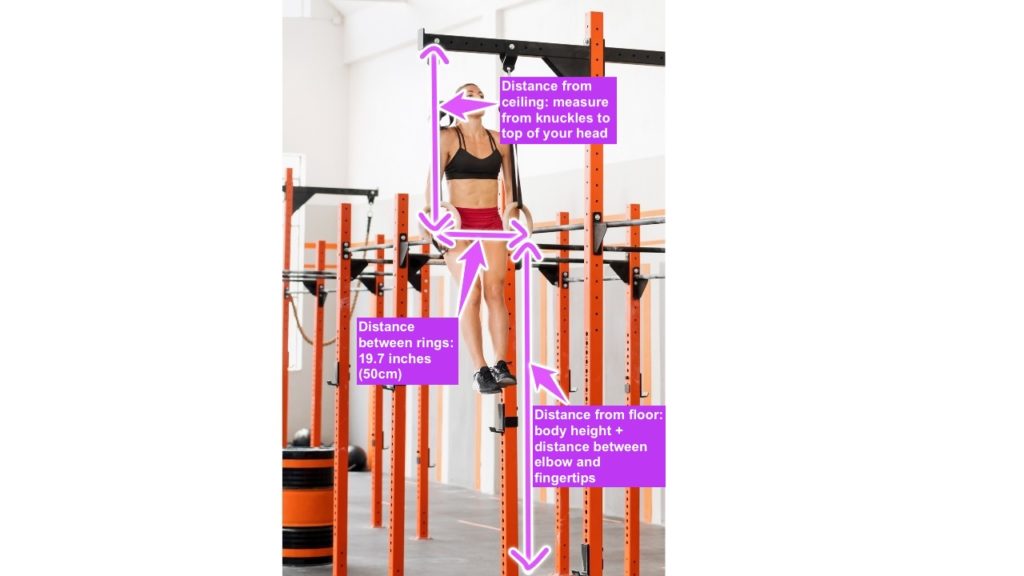
How far apart gymnastics rings should be?
The best way to hang gymnastics rings is on a high enough pull-up bar (or tree branch) because this way the straps can be adjusted easily as needed.
Another way to install gymnastics rings is to drill two attachment points into the ceiling. This solution is more permanent so it’s important to get the width right the first time.
We recommend installing the gymnastics rings slightly wider than shoulder-width apart so supporting yourself in the top of the dip position feels natural – with arms extended and held close to the body. The official FIG (International Gymnastics Federation) specification says that the rings should be 50cm or 19.7 inches apart from each other.
What is the best material for gymnastics rings?
The materials used to make gymnastics rings can vary between
- wood
- plastic
- metal (steel or aluminum)
Typically rings in public calisthenics parks are made of steel or aluminum as they are the most resistant to wear and the weather. Unfortunately, they are very heavy and rough so working out on them takes some getting used to.
Plastic gymnastics rings are usually the lowest quality and they are the cheapest to manufacture. The benefit of these rings is that they are the lightest and most resistant to water. Even though they are completely functional we would not recommend them if you can afford the wooden version.
The best gymnastics rings are made of birch wood where the surface of the rings is untreated and sanded down to provide a natural feel and optimal grip. This is also the material that has been used in competitive gymnastics for decades. Some of the more premium gymnastics rings are made of more exclusive materials such as walnut or maple wood. These are usually significantly more expensive and the benefits tend to be purely aesthetic if any.
What is the best thickness for gymnastics rings?
While the inner diameter of gymnastics rings tends to be uniform at 7.1” (18cm) the thickness varies between the two standard sizes:
- Standard: 1.25″ or 32 mm
- FIG: 1.1” or 28 mm
The FIG version is the official size used in gymnastics competitions. To ensure optimal grip for gymnasts who wear a thick layer of padding on their hands it has to be thinner. Since most of us train with bare hands, the best thickness for gymnastics rings for most athletes is 1.25” (32mm). Of course, for athletes with smaller hands, it is perfectly fine to choose the FIG version – whatever feels better.
Written by: Andy Toth
Andy is the founder of calisthenics.com and he writes about topics related to strength and hypertrophy training.
Andy has over 15 years of experience in calisthenics and before that he spent 8 years practicing and later coaching martial arts (Kyokushin karate). Besides bodyweight strength training he enjoys Olympic weightlifting and cycling. He tries to stay active every day and rides an average 5000 miles per year.
Written by: Andy Toth
Andy is the founder of calisthenics.com and he writes about topics related to strength and hypertrophy training. Andy has over 15 years of experience in calisthenics and before that he spent 8 years practicing and later coaching martial arts (Kyokushin karate). Besides bodyweight strength training he enjoys Olympic weightlifting and cycling. He tries to stay active every day and rides an average 5000 miles per year.



